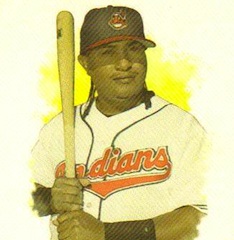 For those still bemoaning a Jason Kipnis-less Midsummer Classic this year, it’s important to remember that for every All-Star snub in Indians history, there have also been plenty of “All-Star scrubs”— guys who had no real business being there, but got in anyway. They may have been the beneficiaries of ballot-box stuffing, a coach’s bias, or the “Every Team Sends Somebody” rule, but no matter their paths to the game, these lucky bastards will always inspire the same question for future generations: “Wait, that guy was an All-Star?” Followed shortly by, “Are you sure about that?”
For those still bemoaning a Jason Kipnis-less Midsummer Classic this year, it’s important to remember that for every All-Star snub in Indians history, there have also been plenty of “All-Star scrubs”— guys who had no real business being there, but got in anyway. They may have been the beneficiaries of ballot-box stuffing, a coach’s bias, or the “Every Team Sends Somebody” rule, but no matter their paths to the game, these lucky bastards will always inspire the same question for future generations: “Wait, that guy was an All-Star?” Followed shortly by, “Are you sure about that?”
Travis Hafner and Shin-Soo Choo have never made an All-Star team. Brook Jacoby made it twice. Jason Kipnis couldn’t beat out his fellow AL second basemen this year, but Ronnie Belliard once did. Just a quick glance up and down the Cleveland Indians’ all-time All-Star squad reveals just how arbitrary these sorts of accolades can often be—even if sportswriters continue to use them as key considerations in a player’s career resume. I mean, yes, Sandy Alomar gave us a great All-Star Game moment in 1997, but when you really look at it, four of Sandy's six career All-Star nods actually came in some of his worst, injury-riddled seasons. You just can’t trust this stuff.
Of course, we’re not suggesting that Jorge Orta should be forced to remove the 1980 All-Star jersey from his mantle (he didn't appear in the game), or that 77 year-old Jack Kralick should be ashamed for thinking back fondly on his lone ASG invite in 1964 (he didn’t appear in the game, either). These guys had very solid Major League careers, and even if they didn’t necessarily belong alongside the legends of their eras, it doesn’t mean they didn’t deserve their respective moments in the sun.
So maybe the term “scrub” is a bit harsh, and maybe I only chose it because it rhymes with “snub” and worked as a cheap literary device. If that is indeed Matt Lawton’s name I see lingering below, however, I am prepared to stick with this premise and carry it to its conclusion.
The Cleveland Indians’ "All-Star Scrubs" Hall of Fame
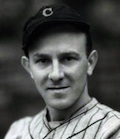 Oral Hildebrand (SP) - 1933
Oral Hildebrand (SP) - 1933
With a name like Oral Hildebrand, you might think the Indians’ first ever All-Star scrub was born in 1907 or something. And you would be right. A surprise addition to the inaugural AL-NL All-Star Game in 1933, the 26 year-old righty never actually got a chance to pitch in the game, as a pair of lefties (literally, Lefty Gomez and Lefty Grove) led the American League to a 4-2 win at Comiskey Park. Oral may have felt a bit out of place in a dugout with the likes of Ruth, Gehrig, and Foxx, but he was also fresh off an 11-5 first half record with a league best five shutouts, so the kid had some confidence brewing. Fact was, though, that Hildebrand just didn’t have very special stuff. He would never make another All-Star Game, nor approach the 16 wins he tallied for the ’33 Tribe. He’d retire in 1940 with an 83-78 career record and 4.35 ERA.
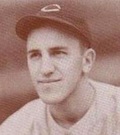 Ray Mack (2B) - 1940
Ray Mack (2B) - 1940
A graduate of John Adams High School in Cleveland, Mack served as the Tribe’s pesky second baseman for the majority of the World War II era. He hit just .232 across eight years with a .631 OPS, but in his first full season—as a wide-eyed 23 year-old—he suited up with Ted Williams, Joe DiMaggio, and teammate Lou Boudreau on the 1940 All-Star team. Young Ray was hitting .318 at the time, and had shown some power, too, with 7 homers. In the game, he pinch-hit for Joe Gordon in the bottom of the eighth inning and went down on strikes against the Cubs’ Larry French. The NL took the contest 4-0, and Ray Mack began his gradual descent into permanent mediocrity.
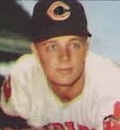 Dick Stigman (SP) - 1960
Dick Stigman (SP) - 1960
He pitched for only six seasons, posting a 46-54 record, a 4.03 ERA, and nary a single transcendent accomplishment—save for an all-important selection to one All-Star Game, of course. Richard Lewis Stigman-- a native son of Nimrod, Minnesota—was actually off to a relatively inauspicious beginning to his rookie season (4-4, 3.80 ERA) when his manager Al Lopez (also manager of the AL All-Stars) decided to drop him into a pool of hurlers that included Whitey Ford and Early Wynn. They actually played two All-Star Games in that summer of 1960 (July 11 in Kansas City and July 13 in New York), but Dick Stigman didn’t end up pitching in either of them. He’d end that season just 5-11 for the Indians, and played out his so-so career mostly with his hometown Twins, never sniffing All-Star status again.
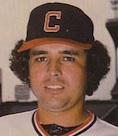 Sid Monge (RP) - 1979
Sid Monge (RP) - 1979
In May of 1977, the Indians traded their kinda not-that-amazing All-Star closer Dave LaRoche to the Angels for a man who would become their new, not-particularly-outstanding fireman, Sid Monge. The crafty Mexican lefty was abysmal in his first year with the Tribe, posting a 6.23 ERA and 1.89 WHIP in 33 games. In the pre-saves mindset of the late ‘70s, though, he soon settled into a role as the axis of the Indians pen, cleaning up Wayne Garland’s messes. At the All-Star break in ’79, Monge was 6-6 with 9 saves and a 1.75 ERA. He was selected as the Indians’ lone, token representative for the game at Seattle’s Kingdome, and never got off the bench. It was Sid’s only ASG nod in his 10-year career. He retired with a 49-40 record, 3.53 ERA, and 56 saves.
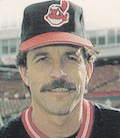 Ken Schrom (SP) - 1986
Ken Schrom (SP) - 1986
What the hell? Seriously? Ken Schrom? I’m glad I didn’t have the unenviable task of informing Joe Carter, Julio Franco, and Brett Butler that their fine efforts weren’t quite up to the All-Star caliber of Ken Schrom in 1986. The Schrominator-- a 30 year-old castoff from the Twins-- got off to an impressive (if fluky) start to his first season in Cleveland, putting together a 10-2 record and 4.17 ERA at the break. You're the man now, Schrom! Unfortunately, Ken never got his number called in the big game, and even more unfortunately, he would only go 4-5 in the second half of the season-- finishing with a mEh-RA of 4.54. On the bright side, those numbers would actually look sparkling compared to the hideously grotesque stats he put up a year later (6-13, 6.50 ERA in 1987). As you may have guessed, Schrom's All-Star selection streak ended at 1.
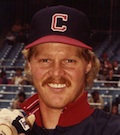 Pat Tabler (1B) - 1987
Pat Tabler (1B) - 1987
The “Indian Uprising” hadn’t quite gone as Sports Illustrated had predicted, but when it came time to send their token cap-tipper to Oakland for the ’87 All-Star Game, the Tribe had their man in mind. Again, it wasn’t Joe Carter-- he never played in an ASG as an Indian. But them’s the breaks when you’re stuck behind Pat Tabler. Now some might say Pat didn’t quite belong in an infield with Wade Boggs, Cal Ripken, and Willie Randolph. But in reality, the only place Pat Tabler doesn’t belong is on this list. I am personally ashamed of myself for even putting him here. The man they called “Mr. Clutch” was a .282 career hitter in the midst of a career-best season (11 HR, 86 RBI, .307 AVG, .809 OPS in '87). So what if he never hit more than 2 homers or drove in more than 60 runs any season afterwards? So what if he never played in any other All-Star Game? Tabler was a proud Indians ambassador. And though he struck out as a pinch hitter in the thirteenth inning of an American League defeat, he’d eventually reunite with Joe Carter to win a ring in Toronto in 1992. So go ahead and call him a banjo hitter. Pat Tabler owns your soul.
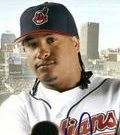 Ronnie Belliard (2B) - 2004
Ronnie Belliard (2B) - 2004
After the ‘90s saw the Tribe send an influx of legitimate superstars to the All-Star Game every year, fans began to long for the good old days when relatively average journeymen used to represent the club at the Midsummer Classic. In 2004, they finally got their wish, as Eric Wedge’s rebuilding Indians sent a crew of five players to the game in Houston. Two of them were brilliant youngsters (CC Sabathia and Victor Martinez), and one was a steady #2 pitcher (Jake Westbrook), but the other two were true Cleveland throwbacks-- just a couple of dudes, really. As has been the pattern on this list, Ronnie Belliard got just one pinch-hit at-bat in his lone career All-Star appearance, and he struck out. Like Pat Tabler before him, Belliard was an underrated little hitter, and he was certainly at an offensive peak during his 2+ year stint in Cleveland (he hit .285 with 37 HR and 192 RBI in 390 games as an Indian). Still, across his career, Ronnie’s closest statistical equals at second base include the remarkably average Adam Kennedy, Carlos Guillen, and Damion Easley. People did not tune into the All-Star Game hoping to see Roger Clemens stare down Ronnie Belliard.
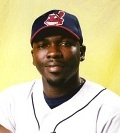 Matt Lawton (OF) - 2004
Matt Lawton (OF) - 2004
But perhaps they DID tune in to see Tom Glavine vs. Matt Lawton. If so, the ancient peoples of 2004 would have been delighted to see the underdog prevail, as Lawton singled in his first at-bat (the only man on this entire list who did anything whatsoever in the actual All-Star Game). Matty would strikeout against Eric Gagne in his second and final go-round, but nobody except for everybody thought it would be the final ASG at-bat of his career. It’s easy to forget that Lawton—once a top prospect with the Twins—had played in an All-Star game for Minnesota back in 2000. By ’04, though, he was 32 and recovering from two straight awful seasons. This made his numbers in the first half of the 2004 season all the more surprising (15 HR, 49 RBI, .305 AVG). Again, he was a pretty deserving All-Star selection. By the end of year, though, he had all-too-predictably sunk right back into the doldrums, only managing 5 homers and 21 ribbies the rest of the way, while his average fell to .277. He was out of the league less than two years later. No plans for a Matt Lawton statue are currently in the Progressive Field budget. But dammit, he was an All-Star.
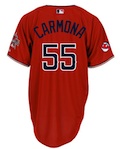 ??????? - 2010
??????? - 2010
This jersey was supposedly warn by an undeserving Cleveland Indian at the 2010 All-Star Game. Looking at the available statistics, however, there is no record of anyone by that name participating in said game.